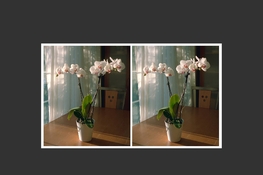Donald Qualls
Subscriber
I recently picked up a Stereo Graphic from the classifieds here for a very reasonable (IMO) price. Included was an everready case that looks brand new except for the tripod screw missing, and the camera itself looks new except for needing some cleaning of the viewfinder windows (dirt was on the outside, a Q-tip took it right off).
There's not much out there on this camera model; apparently it wasn't as popular as the Stereo Realist (or came to that market too late?). It makes simultaneous 24 (high) by 23 (wide) exposures, with twice that width between, so it can advance by 10 perfs each exposure and get consistent frames, 26 pairs on a 36 exposure roll. The lenses are 35 mm f/4 triplets, and the only control is an aperture knob between the lenses with settings from f/4 to f/16 and weather descriptions for ISO 25 (Kodachrome of the day), though inside the top of the case is an exposure chart that also covers Ektachrome and Agfachrome, presumably ISO 64. In digging for information, however, I came upon an advertisement referring to "Depthmaster Auto-Focus" -- which, with a little reading in, seems to indicate the set focus for the two lenses differs, so that their depth of field will ensure one frame or the other is sharp at any reasonable distance even with the apertures wide open.
This seems like a remarkably simple way to make stereo photography easier -- which was much of the, um, focus of this model, of course. Has anyone used one of these who can confirm this conjecture? I just loaded mine, but haven't had a chance to shoot yet (and may rewind the XP2 and load something slower, since the camera is built around ISO 25-64).
There's not much out there on this camera model; apparently it wasn't as popular as the Stereo Realist (or came to that market too late?). It makes simultaneous 24 (high) by 23 (wide) exposures, with twice that width between, so it can advance by 10 perfs each exposure and get consistent frames, 26 pairs on a 36 exposure roll. The lenses are 35 mm f/4 triplets, and the only control is an aperture knob between the lenses with settings from f/4 to f/16 and weather descriptions for ISO 25 (Kodachrome of the day), though inside the top of the case is an exposure chart that also covers Ektachrome and Agfachrome, presumably ISO 64. In digging for information, however, I came upon an advertisement referring to "Depthmaster Auto-Focus" -- which, with a little reading in, seems to indicate the set focus for the two lenses differs, so that their depth of field will ensure one frame or the other is sharp at any reasonable distance even with the apertures wide open.
This seems like a remarkably simple way to make stereo photography easier -- which was much of the, um, focus of this model, of course. Has anyone used one of these who can confirm this conjecture? I just loaded mine, but haven't had a chance to shoot yet (and may rewind the XP2 and load something slower, since the camera is built around ISO 25-64).







 Gone now, but I grabbed a different one off eBay. I could make a viewer easily enough, and I'm nearsighted enough not to need lenses in a cardboard viewer -- or I can print the images and use a Holmes type viewer -- but having a viewer and the ability to make mounts makes everything easier.
Gone now, but I grabbed a different one off eBay. I could make a viewer easily enough, and I'm nearsighted enough not to need lenses in a cardboard viewer -- or I can print the images and use a Holmes type viewer -- but having a viewer and the ability to make mounts makes everything easier.
